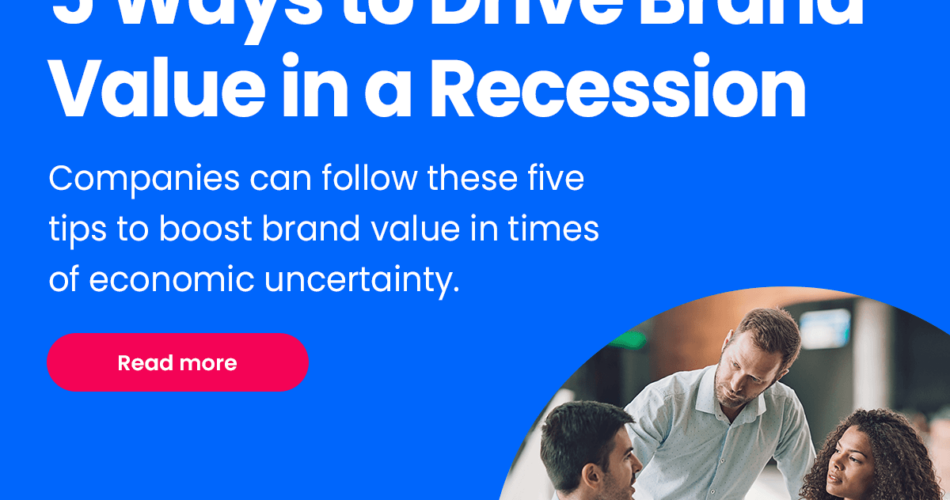The United States is currently experiencing one of the highest levels of economic uncertainty in over forty years. The consumer price index has increased over 9% since the previous year, sparking the highest inflation rate since November 1981. And Bloomberg predicts there’s a 38% chance of a recession within the next 12 months. It’s times like these that make B2B buyers hyper aware of their spending.
Customers want to ensure they receive the biggest bang for their buck. But with operating costs now at an all-time high, it’s become more expensive than ever to deliver the kinds of products and services today’s buyer demands. So, while customers have tightened their belts and limited costly spending, companies, meanwhile, have increased prices to cover their rising overhead costs.
Therein lies the predicament: how can B2B companies prove value and maintain customer relationships in a market surrounded by economic uncertainty? Here are five key tips to follow:
1. Create a Value-Based Strategy
B2B companies, take note: customers need assurance their purchase decision provides not just immediate value, but long-term benefits as well. So consider offering prospects an extended trial period, or introduce a “freemium” option—a pricing model that offers complimentary access to a certain product, with supplementary costs attached to additional features that ultimately expand product functionality. With this value-based strategy, customers can pay an incremental increase for continued use of a product, which can lead to future opportunities for customer upsells.

2. Maintain Marketing Spend
During tough economic times, it’s natural for B2B organizations to pull back and cut costs whenever possible. But it’s also important companies don’t get too overzealous with their spending cuts. Marketing teams working on limited budgets run the risk of negatively impacting brand reputation.
Instead, companies should maintain existing spend and double down on relevant, value-based messaging for price-conscious customers. Take it from Matt Kleinschmit, CEO and founder of Reach3 Insights:
“Brands that continue to engage with consumers in emotionally meaningful, culturally relevant ways can build mind share and drive sales, while those that reduce or stop their advertising are often left out of purchase decisions.”
That said, there’s no better time than the present to inject your marketing strategy with some personalized content specifically tailored to meet customers’ interests. And with the right content strategy in place, marketers can even boost quality lead generation among target B2B buyers.
3. Understand Customer Goals
In tough economic times, customers look to companies they can trust, which is why it’s essential B2B organizations demonstrate empathy, authenticity, and a solid understanding of target prospects’ needs, challenges, and strategic goals. Sales and marketing teams can use these insights to craft cost-effective, solution-driven messaging that reinforces brand expertise, reliability, and value. The more companies can lead with an empathetic foot, the better.

4. Don’t Pull Back on Paid Advertising
When it comes to media buying, it’s all about working smarter, not harder. And believe it or not, economic uncertainty can actually provide B2B marketers unique opportunities to optimize paid advertising ROI. Here’s how:
During a recession, it’s typical to see marketing and advertising demand taper off, resulting in lower costs for ad space. Combine these two scenarios, and what’s left is a lot of empty slots up for grabs. That’s when B2B marketing teams can take advantage of discounted ad inventory in a less competitive market.
And while conversion rates might dip below average as target prospects keep a closer eye on their budgets, it’s important to remember that the discounted costs to engage ideal customers could outweigh the negative effect of a less-than-ideal conversion rate.
5. Embrace Outsourcing
We know it’s hard to ask for help. But when resources run limited, B2B companies need to keep an open mind about outsourcing talent. DemandScience Chief Revenue Officer, Chris Rack, even agrees, saying companies can certainly boost brand value while keeping an eye on costs, simply by tapping outside talent to manage specific job functions.
For example, B2B organizations can outsource sales development staff to handle the more technical, time-consuming aspects of the role, leaving in-house teams extra time to focus on strategic, revenue-driving lead generation. Not only that, but outsourced SDRs bring years of professional experience to the table at a fraction of the cost of a full-time staff member. These savings can then get passed along to customers, thereby improving brand value and reputation in the process.
Final Thoughts
Yes, inflation is at an all-time high, operating costs are on the rise, and customers have become more price-conscious and risk-averse than ever before. But by embracing a few key cost-effective strategies, B2B brands can demonstrate value and gain key market share, even in a market marred with uncertainty.
***
Want to learn how to plan more efficiently for your next big B2B campaign? Check out our blog, “Budget Like a CEO and Optimize Your Marketing Expenses.”
Source link



